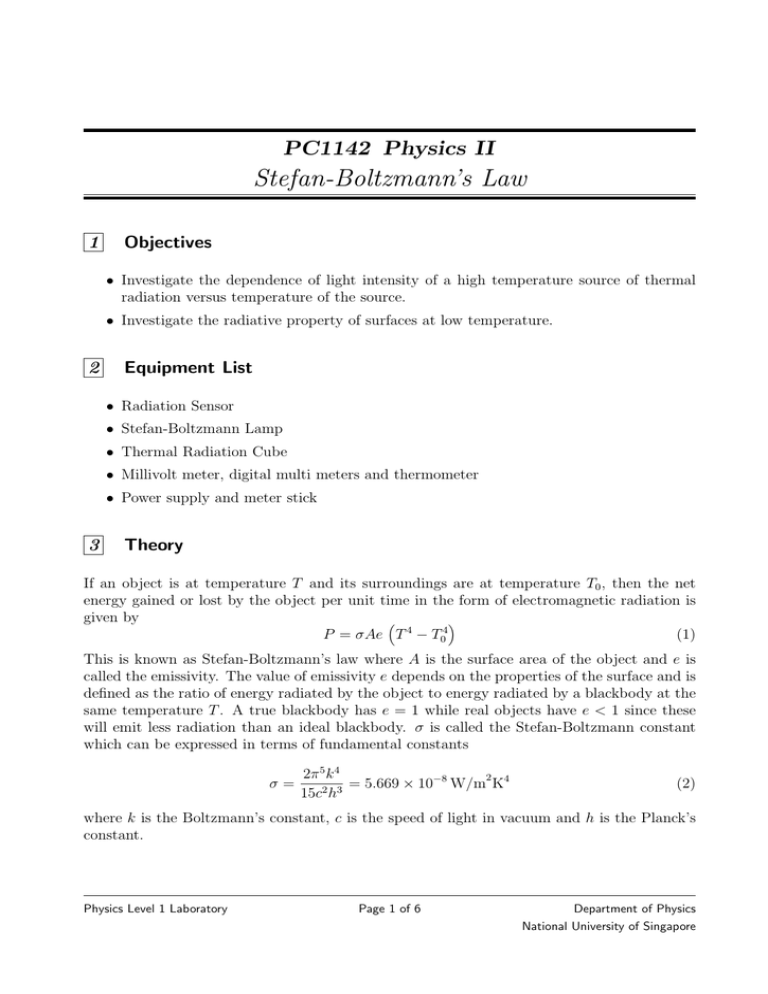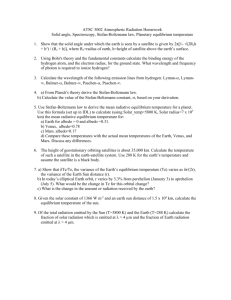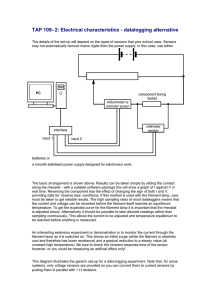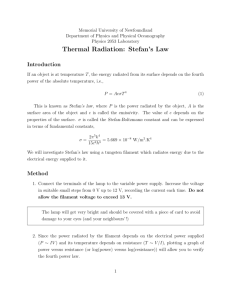Stefan-Boltzmann`s Law - Department of Physics
advertisement

PC1142 Physics II Stefan-Boltzmann’s Law 1 Objectives • Investigate the dependence of light intensity of a high temperature source of thermal radiation versus temperature of the source. • Investigate the radiative property of surfaces at low temperature. 2 Equipment List • Radiation Sensor • Stefan-Boltzmann Lamp • Thermal Radiation Cube • Millivolt meter, digital multi meters and thermometer • Power supply and meter stick 3 Theory If an object is at temperature T and its surroundings are at temperature T0 , then the net energy gained or lost by the object per unit time in the form of electromagnetic radiation is given by P = σAe T 4 − T04 (1) This is known as Stefan-Boltzmann’s law where A is the surface area of the object and e is called the emissivity. The value of emissivity e depends on the properties of the surface and is defined as the ratio of energy radiated by the object to energy radiated by a blackbody at the same temperature T . A true blackbody has e = 1 while real objects have e < 1 since these will emit less radiation than an ideal blackbody. σ is called the Stefan-Boltzmann constant which can be expressed in terms of fundamental constants σ= 2π 5 k 4 = 5.669 × 10−8 W/m2 K4 15c2 h3 (2) where k is the Boltzmann’s constant, c is the speed of light in vacuum and h is the Planck’s constant. Physics Level 1 Laboratory Page 1 of 6 Department of Physics National University of Singapore Stefan-Boltzmann’s Law 4 Page 2 of 6 Laboratory Work Part A: Light Intensity versus Temperature In this part of the experiment, you will make relative measurements of the power per unit area emitted from a hot object, namely the Stefan-Boltzmann Lamp, at various temperatures. From your data, you will be able to test whether the radiated power is really proportional to the forth power of the temperature. The Stefan-Boltzmann Lamp, is a high temperature source of thermal radiation. The high temperature simplifies the analysis because the fourth power of the ambient temperature is negligibly small compared to the fourth power of the high temperature of the lamp filament. A-1. BEFORE TURNING ON THE LAMP, measure the room temperature in Kelvin and the resistance of the filament of the Stefan-Boltzmann Lamp at room temperature. Record them as Tref and Rref in Data Table 1. The Stefan-Boltzmann Lamp is a high temperature source of thermal radiation. By adjusting the power into the lamp (13 V max, 2 A min, 3 A max), filament temperatures up to approximately 3000◦ C can be obtained. The filament temperature is determined by carefully measuring the voltage and current into the lamp. The voltage divided by the current gives the resistance of the filament. Figure 1: Stefan-Boltzmann Lamp. A-2. Set up the equipment as shown in Figure 2. The voltmeter should be connected directly to the binding posts of the Stefan-Boltzmann Lamp. Figure 2: Equipment setup. Physics Level 1 Laboratory Department of Physics National University of Singapore Stefan-Boltzmann’s Law Page 3 of 6 A-3. Adjust the height of the Radiation Sensor so that it is at the same height as the filament with the front face of the sensor approximately 6 cm away from the filament (see Figure 2). Figure 3: Radiation Sensor. Note: The Radiation Sensor measures the relative intensities of incident thermal radiation. The sensing element, a miniature thermopile, produces a voltage proportional to the intensity of the radiation. The spectral response of the thermopile is essentially flat in the infrared region (from 0.5 to 40 µm) and the voltages produced range from the microvolt range up to around 100 millivolts. A spring-clip shutter is opened and closed by sliding the shutter ring forward or back. During experiments, the shutter should be closed when measurements are not actively being taken. This helps reduce temperature shift in the thermopile reference junction which can cause the sensor response to drift. The two posts extending from the front end of the sensor protect the thermopile and also provides a reference for positioning the sensor a repeatable distance from a radiation source. A-4. Make sure that the entrance angle of the thermopile should include no CLOSE objects other than the lamp. A-5. Turn on the power supply. Set the voltage V to each of the settings listed in Data Table 1. At each voltage setting, record the ammeter reading (current) as I and the reading on the millivolt meter as Rad in Data Table 3. Note: Make each sensor reading quickly. Between readings, place both sheets of insulating foam between the lamp and the sensor, with the silvered surface facing the lamp, so that the temperature of the sensor stays relatively constant. Physics Level 1 Laboratory Department of Physics National University of Singapore Stefan-Boltzmann’s Law Page 4 of 6 Part B: Radiative Property of Surfaces In this part of the experiment, you will investigate Stefan-Boltzmann law at much lower temperatures with four different radiating surfaces: black, white, polished aluminium and dull aluminium. At these lower temperatures, the ambient temperature cannot be ignored. Figure 4: Equipment setup. B-1. Set up the equipment as shown in Figure 4. The Radiation sensor should be pointed directly at the center of the black surface. The fact of the sensor should be parallel with the surface of the cube and about 3 to 4 cm away. B-2. With the Thermal Radiation Cube off, measure the resistance of the thermistor at room temperature and record it as Rrm in Data Table 2. The Thermal Radiation Cube provides four different radiating surfaces that can be heated from room temperature to approximately 120◦ C. The cube is heated by a 100 watt light bulb. Just plug in the power cord, flip the toggles witch to “ON”, then turn the knob clockwise to vary the power. The temperature of cube is determined via resistance measurement by plugging ohmmeter into the the banana plug connectors labeled THERMISTOR. The thermistor is embedded in one corner of the cube. Figure 5: Thermal Radiation Cube. B-3. Shield the sensor from the cube using the reflecting heat shield with the reflective side of the shield facing the cube. Note: As long as you are careful to shield the Radiation Sensor from the Thermal Radiation Cube when measurements are not being taken, the temperature of the sensor will be very close to room temperature. Physics Level 1 Laboratory Department of Physics National University of Singapore Stefan-Boltzmann’s Law Page 5 of 6 B-4. Turn on the Radiation Cube and set the power switch to 10. B-5. When the thermistor resistance indicated that the temperature is about 12◦ C above room temperature, turn the power down so the temperature is changing slowly. Read and record the ohmmeter reading as R and the millivolt meter reading as Rad in Data Table 2. The readings should be taken as nearly simultaneously as possible while briefly removing the heat shield. Note: Make each reading quickly, removing the heat shield only as long as it takes to make the measurement. Take care that the position of the sensor with respect to the cube is the same for all measurements. B-6. Replace the heat shield and turn the cube power to 10. When the temperature has risen an additional 12–15◦ C, repeat the measurement of step B-5. Repeat this procedure at about 12–15◦ C intervals until you have at leat FIVE sets of data. B-7. Repeat the procedure for the other THREE surfaces and record your readings in Data Table 2. A Stefan-Boltzmann Lamp Temperature and Resistivity for Tungsten R/R300 K 1.0 1.43 1.87 2.34 2.85 3.36 3.88 4.41 4.95 5.48 6.03 6.58 Temp ◦ K 300 400 500 600 700 800 900 1000 1100 1200 1300 1400 Resistivity R/R 300 K µΩ cm 5.65 7.14 8.06 7.71 10.56 8.28 13.23 8.86 16.09 9.44 19.00 10.03 21.94 10.63 24.93 11.24 27.94 11.84 30.98 12.46 34.08 13.08 37.19 13.72 Physics Level 1 Laboratory Temp ◦ K 1500 1600 1700 1800 1900 2000 2100 2200 2300 2400 2500 2600 Resistivity R/R 300 K µΩ cm 40.36 14.34 43.55 14.99 46.78 15.63 50.05 16.29 53.35 16.95 56.67 17.62 60.06 18.28 63.48 18.97 66.91 19.66 70.39 26.35 73.91 77.49 Temp ◦ K 2700 2800 2900 3000 3100 3200 3300 3400 3500 3600 Resistivity µΩ cm 81.04 84.70 88.33 92.04 95.76 99.54 103.3 107.2 111.1 115.0 Department of Physics National University of Singapore Stefan-Boltzmann’s Law B Page 6 of 6 Thermal Radiation Cube Resistance versus Temperature Res. (Ω) 207,850 197,560 187,840 178,650 169,950 161,730 153,950 146,580 139,610 133,000 126,740 120,810 115,190 109,850 104,800 100,000 95,447 91,126 87,022 83,124 79,422 75,903 72,560 69,380 66,356 63,480 60,743 58,138 55,658 53,297 Temp. (◦ C) 10 11 12 13 14 15 16 17 18 19 20 21 22 23 24 25 26 27 28 29 30 31 32 33 34 35 36 37 38 39 Res. Temp. (Ω) (◦ C) 51,048 40 48,905 41 46,863 42 44,917 43 43,062 44 41,292 45 39,605 46 37,995 47 36,458 48 34,991 49 33,591 50 32,253 51 30,976 52 29,756 53 28,590 54 27,475 55 26,409 56 25,390 57 24,415 58 23,483 59 22,590 60 21,736 61 20,919 62 20,136 63 19,386 64 18,668 65 17,980 66 17,321 67 16,689 68 16,083 69 Res. Temp. (Ω) (◦ C) 15,502 70 14,945 71 14,410 72 13,897 73 13,405 74 12,932 75 12,479 76 12,043 77 11,625 78 11,223 79 10,837 80 10,467 81 10,110 82 9,767.2 83 9,437.7 84 9,120.8 85 8,816.0 86 8,522.7 87 8,240.6 88 7,969.1 89 7,707.7 90 7,456.2 91 7,214.0 92 6,980.6 93 6,755.9 94 6,539.4 95 6,330.8 96 6,129.8 97 5,936.1 98 5,749.3 99 Res. Temp. (Ω) (◦ C) 5,569.3 100 5,395.6 101 5,228.1 102 5,066.6 103 4,910.7 104 4,760.3 105 4,615.1 106 4,475.0 107 4,339.7 108 4,209.1 109 4,082.9 110 3,961.1 111 3,843.4 112 3,729.7 113 3,619.8 114 3,513.6 115 3,411.0 116 3,311.8 117 3,215.8 118 3,123.0 119 3,033.3 120 2,946.5 121 2,862.5 122 2,781.3 123 2,702.7 124 2,626.6 125 2,553.0 126 2,481.7 127 2,412.6 128 2,345.8 129 Res. Temp. (Ω) (◦ C) 2,281.0 130 2,218.3 131 2,157.6 132 2,098.7 133 2,041.7 134 1,986.4 135 1,932.8 136 1,880.9 137 1,830.5 138 1,781.7 139 1,734.3 140 1,688.4 141 1,643.9 142 1,600.6 143 1,558.7 144 1,518.0 145 1,478.6 146 1,440.2 147 1,403.0 148 1,366.9 149 1,331.9 150 Last updated: Friday 8th August, 2008 5:08am (KHCM) Physics Level 1 Laboratory Department of Physics National University of Singapore




